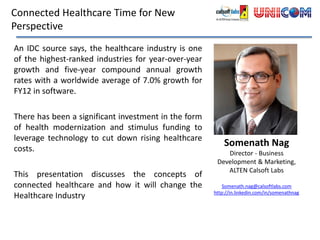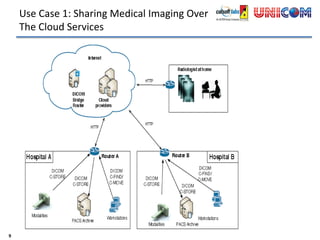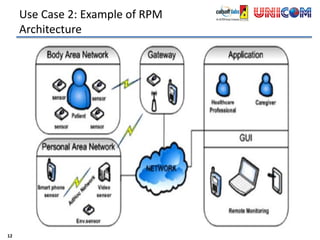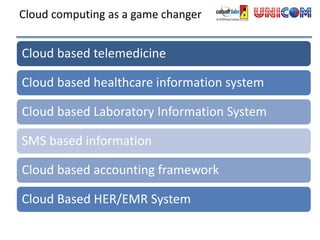Connected Healthcare - New Perspective
- 1. Somenath Nag Director – ISV & Enterprise Solutions ALTEN Calsoft Labs (http://www.calsoftlabs.com) Fundamentals of Cloud Computing Conference (c)
- 2. Connected Healthcare Time for New Perspective An IDC source says, the healthcare industry is one of the highest-ranked industries for year-over-year growth and five-year compound annual growth rates with a worldwide average of 7.0% growth for FY12 in software. There has been a significant investment in the form of health modernization and stimulus funding to leverage technology to cut down rising healthcare costs. This presentation discusses the concepts of connected healthcare and how it will change the Healthcare Industry Somenath Nag Director – ISV & Enterprise Solutions, ALTEN Calsoft Lab Somenath.nag@calsoftlabs.com http://in.linkedin.com/in/somenathnag
- 3. Challenges Faced by Healthcare Industry Strong need for cost reduction Strong need for operating efficiencies and increased productivity Expand access to care Need to automate care delivery processes and systems Transition from reactive to proactive care Need to modernize legacy applications and systems Demonstrate greater healthcare value to all stakeholders Comply with regulations and security mandates 3 Use data to analyze and improve clinical and business performance to improve sustainability
- 4. Healthcare IT Trends 4 Source: CDW.com
- 5. The State of the Wireless Medical Device Market • By 2020 at least 160 million Americans will be monitored and treated remotely for at least one chronic condition. • The market for such remote monitoring of patients was $3.8 billion in 2008 and is forecast to reach $5.1 billion by 2013 • The glucose monitoring market alone (including wireless monitoring) represented an $11.6 billion market • The total IVD market was $42 billion in 2007 and it is projected to grow at about 6.2 percent annually. • By 2025 an additional $10-$12 billion will be added to this market 5 5
- 6. Connected Healthcare Could Enable Healthcare in the Future in Many Ways 6
- 8. Cloud & Connected Health 8
- 9. Use Case 1: Sharing Medical Imaging Over The Cloud Services 9
- 10. Use Case 1: Sharing Medical Imaging over The Cloud Services – Data Flow Hospital A contains a workstation that accesses to the PACS archive of the Hospital B. The communication flows in the intranet to the Router, and the router forward the messages through the Cloud services and the Bridge. 10
- 11. Use Case 2: Remote Patient Monitoring Solutions • The RPM concept has been implemented in a number of different scenarios over time. The Solutions typically consist of four key elements: – Sensors enabled by wireless communications – Local repository for data storage equipped to communicate with sensors and other centralized repositories and/or health care professionals – Centralized repository for data storage equipped to communicate with sensors, local repositories, diagnostic applications and/or health care professionals – Diagnostic application software which analyzes the raw data gathered by the sensors and develops treatment recommendations and/or courses of action • These elements are deployed in differing combinations using differing sensor and communication technologies depending on the specific implementation. 11
- 12. Use Case 2: Example of RPM Architecture 12
- 13. Use Case 3: Cloud Computing Solution for Patient’s Data Collection Traditional Manual Solution Cloud Based Automated Solution Advantages • • • 13 it provides always-on, real-time data collecting; it eliminates manual collecting work and possibility of typing errors; and it facilitated the deployment process, as wireless networking means no need for cabling or other physical setup.
- 14. Challenges Faced by Indian Healthcare Industry Accessibility • Inadequate access to healthcare delivery has been a key issue with the Indian healthcare system • Though most Indians, especially rural population, depend of public health infrastructure, it is inefficient and inadequate too, with low investments in medical infrastructure, including devices and automation Affordability • Since most of the country’ population cannot afford to pay for healthcare, providers in turn pay careful attention to costs • Due to this we are yet to see any large scale initiatives in automating the diagnostic, care, and follow-up processes Fragmentation • The Indian healthcare industry is highly fragmented and dominated by many private players with low market share • Absence of any major player with a pan India presence means low automation and integration of systems and online collaboration Quality of Care • Inequitable quality of care, along with non-availability doctors in rural India, is a major challenge faced by Indian healthcare industry. • This is partially fuelled by demand supply gap that exists with respect to doctors and trained medical professionals
- 15. Areas with higher potential of IT Investment Hospital management systems Telemedicine systems Patient health record portals Laboratory information management system
- 16. Cloud computing as a game changer Cloud based telemedicine Cloud based healthcare information system Cloud based Laboratory Information System SMS based information Cloud based accounting framework Cloud Based HER/EMR System
- 17. Conclusion • Disrupting technologies like cloud & mobility will be a major driver in changing the face of Indian healthcare industry and making India a healthy nation • Saas or Cloud based solutions eliminate the need of fixed costs in the form of IT infrastructure and converts the complete IT application cost to a variable cost • SaaS & Cloud computing are enabling smaller companies to adopt IT faster than earlier and to become more competitive in market place. • It is imperative that healthcare providers need to show agility, and out of the box thinking capability to come out with IT strategy that is functional as well as cost effective and use technology to provide innovative solutions to contribute to this growth journey ©Calsoft Labs, 2013


















